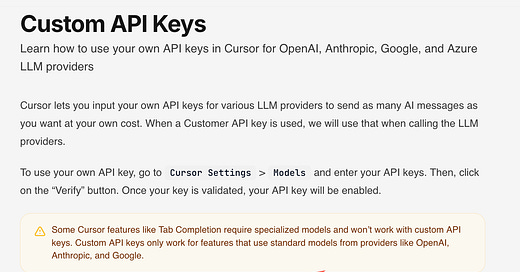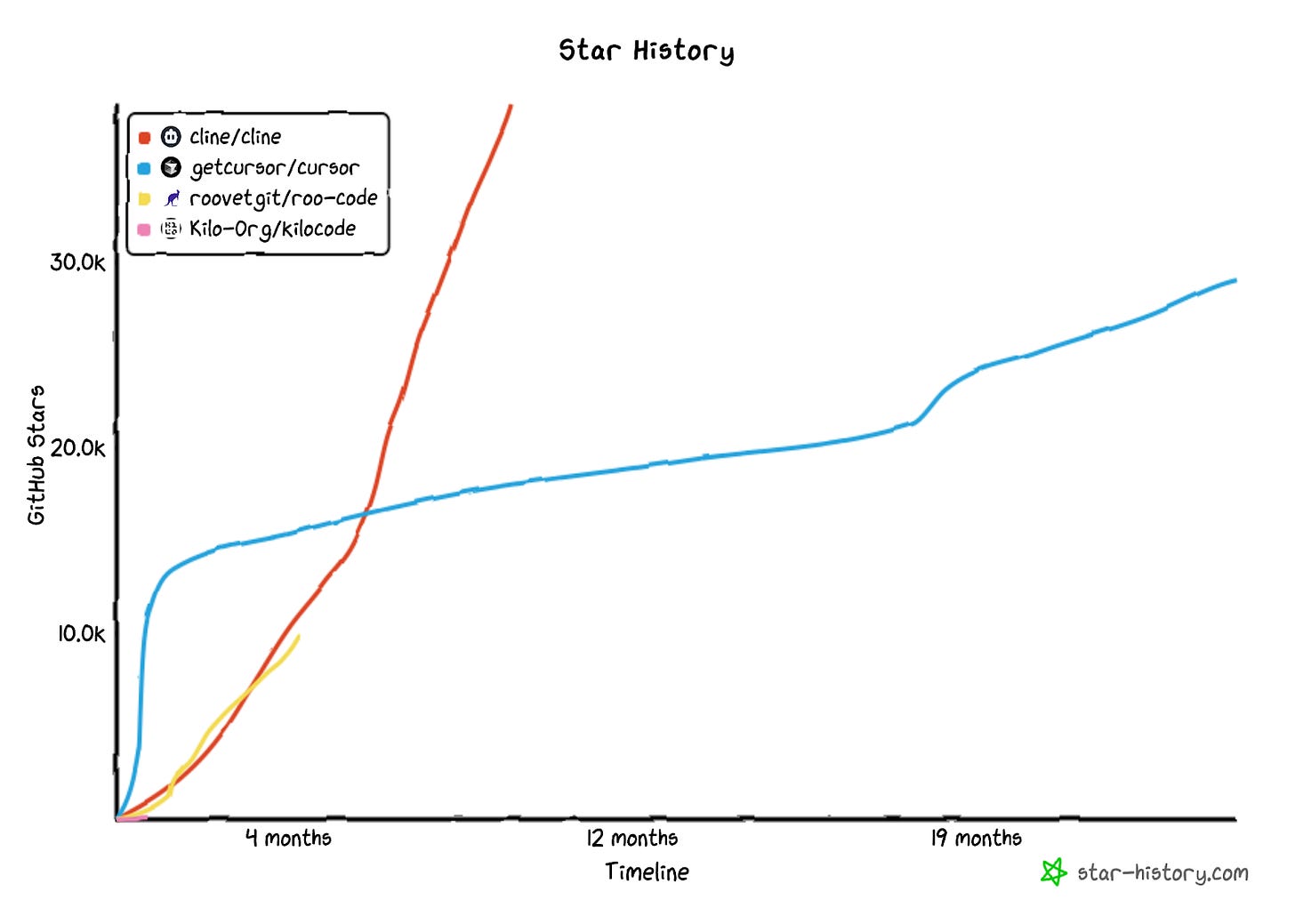Why Cursor's flat-fee pricing could lead to its downfall
AI costs rise directly with usage. You pay for both input and output tokens and get a final price as a result.
Cursor and other popular AI coding tools use flat-rate pricing despite AI's usage-based nature. In my opinion, this creates more problems than it solves and has a tendency to disappoint users.
In this article, I’ll talk specifically about Cursor, but many of the principles can also be applied to competing products that charge flat rates (e.g. Windsurf).
Flat-fee AI pricing distorts people's perception of real costs
Cursor has a recurring subscription plan. You pay $20/mo and get 500 code completions from premium models like Claude 3.7.
The tricky part comes when you “run out” of your current plan. This is where reality starts to creep-in. There’s a lack of clear consensus on how to solve this among flat-fee AI providers. I’ve seen tools that:
Throttle users’ requests after they exceed their quota (Cursor does this)
Get people to switch to an inferior model (your code generation quality drops significantly as a result)
They just reveal the real pricing model and ask people pay-per-used-tokens (people didn’t subscribe for this)
Ask people to upgrade to a higher plan that costs significantly more
Flat-fee pricing for access to AI models can be summarized as: Painless now, feel the real pain later.
Maintain your subscription or get less functionality (subscription lock-in)
Cursor and other flat-fee providers send a clear message early: Continue paying us monthly for a standard+ plan or you’re going to lose a bunch of functionality.
This is the second misaligned incentive with flat-based pricing for AI tools: They take away core functionality unless you’re subscribed to a paid, flat-fee plan.
With Cursor, for example, I can import my own API keys but there are a few “gotchas”:

Pay-as-you-go AI providers don’t create “win-lose” incentives for users
I’ve seen the rise of AI coding tools, such as Cline and Roo Code that ignore this “flat fee” pricing philosophy altogether.
Instead, what they do is charge “per-usage”; any costs they incur go directly to the AI model API of your choice. Cline/OpenRouter’s monetization model is simple: Add a 5% markup on top of anything you pay your API provider.
What do actual users think about all this?
The sentiment is positive. When you look at how fast those AI tools are growing, you’ll see a nice curve. This is Cline’s Github popularity (counted by the # of stars) from 2024 till now:
Those stars translate into downloads; Cline currently has over 1.1 million downloads.
Roo Code is a fork of Cline that has close to 10k stars on Github and 300k+ downloads in less than a year.
Kilo Code (us!) is a fork of Roo Code that went on the front page of Hacker News recently and is also growing rapidly (to the point where people started abusing our free tier), but that’s for another story.
How this pricing “scheme” works: Once you submit an “API request”, it goes through your preferred API model of choice. You can either enter your API key and pay the provider directly or use a direct relay (Cline and Kilo Code both have one) where you don’t have the same rate limits and get a certain amount of free tier credits.
When incentives are aligned, you also have a clear incentive to decrease costs
This has been an interesting observation.
I’ve seen a lot of innovation around the goal of decreasing the costs needed in order to fulfill a meaningful “code completion” request, especially for existing projects.
None of this recent innovation came from Cursor:
Cline was the first to introduce a memory bank with a simple workflow (Cursor has hacky ways to do the same thing).
Roo also has a vibrant community offering several libraries for optimizing your prompts
There’s also an ongoing effort to create an efficient way to use the cheapest price/results model for the task you’re trying to do (if you have any suggestions for this, let us know!)
As I’ve mentioned before, Cursor has been lagging behind here.
What’s the real reason why Cline is crushing it when it comes to cost innovation, while Cursor is running behind? Properly aligned incentives in my opinion:
With Cline/Roo/Kilo Code, you pay for usage (input/output tokens). Those costs are salient (as they should be). You can literally feel the pain of spending money. So people find ways to reduce it.
With Cursor, the picture is a bit fuzzy. You’re “using your flat-fee plan” up until a point where you get throttled/asked to upgrade (which usually comes as a surprise). Psychologically speaking, you get instant gratification but suffer later.
Incentives make a way bigger impact on our world than we think. There’s even been entire books written about this topic.
Is Cursor going to get disrupted just because of its pricing strategy?
Time will tell. There are other factors at play here; for example, 2 years ago, it was tough to get a “Cursor experience” in VS Code. Nowadays, you have some really good extensions that can do at least 80% of what Cursor does. No need to change your IDE.
There’s also the factor of Open Source; both Cline and Roo have 100s of open-source contributors, and 1000s of people in their Discord are constantly suggesting new features. That’s the power of open source.
All these are important, yet many forget about pricing as a factor, the incentives it creates, and how it will impact the “AI coding tools” race as a whole.
I hope that this article has helped clarify the underlying issues at stake.




